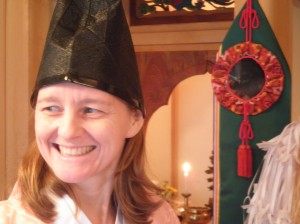 1) Previously we had an interview with your friend, Pat Ormsby. I believe you also trained at Asakawa Konpira, as well as doing the residential course at Kotohira. How did you find it?
1) Previously we had an interview with your friend, Pat Ormsby. I believe you also trained at Asakawa Konpira, as well as doing the residential course at Kotohira. How did you find it?
I loved it. From the basic routine of lights out at 10.00pm and getting up at 5.00am, no TVs, computers or daily hassles. The idea of retreats has always appealed to me and this one is such a different space, where your mind is totally occupied with the task at hand—whether to move your left foot first or right, whether to bow or not, long hours of sitting in seiza and chanting and wondering how to make your legs function again, etc. etc. I’ve never been on any ‘spiritual retreats’, but I think this may be a little different in that you are not just trying to achieve heightened personal awareness but you are committing to a community – the one at the Kotohira Hongu, but also the one at your home shrine, your local community.
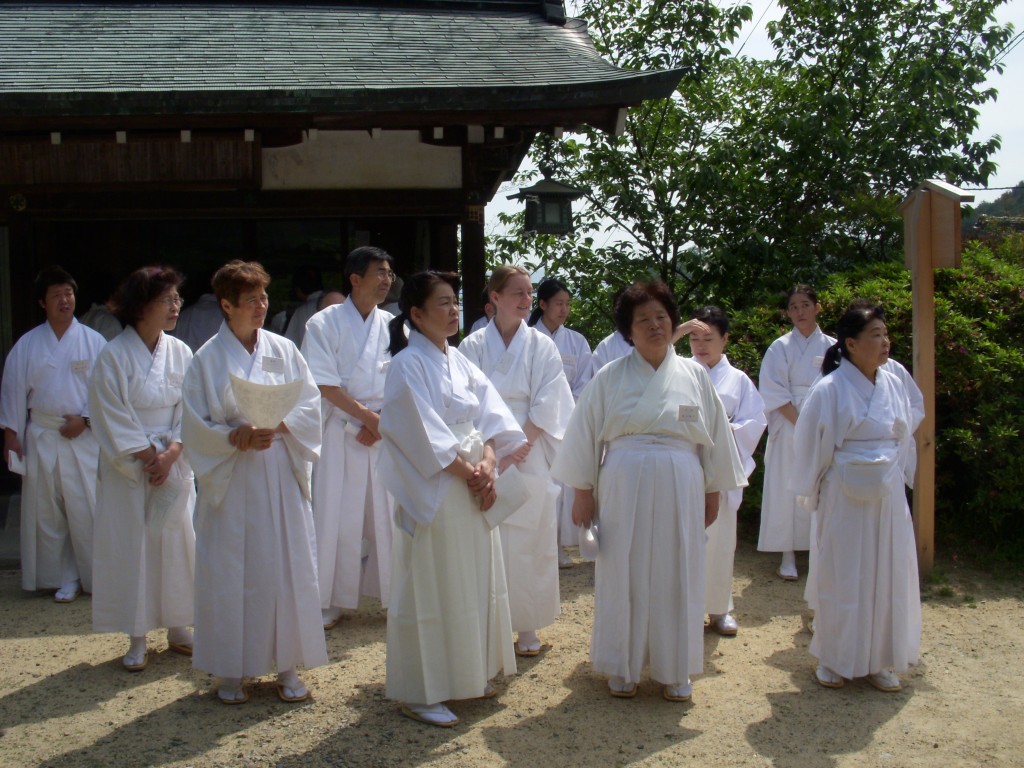
Participants on the Kotohira training course are predominately female, unlike elsewhere
2) You’re presently in India, but after qualifying in what way did you practise as a priest?
When I was in Japan I lived very close to the Asakawa Konpira, so I was there quite often for the monthly ceremony and New Year duties. I’ve also done ground-breaking ceremonies, weddings and funerals, a house-warming ceremony for a community tree-house and I did a ceremony to pray for the souls of all the people who died on the Hachioji-jo mountain hundreds of years ago. It’s conducted annually by a group that is trying to preserve the natural environment of the area. Basically, whatever was needed in the local community.
3) How have Japanese reacted to you? Was there any resistance to the idea of a foreign priest?
I went along to the Kotohira course a year after Pat Ormsby, so I think she’d cleared up any resistance at the main shrine! Once I did a lecture entitled ‘Spiritual Environmentalism’ at the Jinja Honcho which, of course, represents the establishment, and while there was what might be called resistance, or maybe just a certain suspicion, when we first approached them, by the time I actually was doing the presentation, they gave me a very nice introduction in which they said that in this day and age young Japanese are often completely ignorant of Shinto and it’s nice to see foreigners taking such an interest. People are often surprised to see a foreign priest, of course, but mostly they are very happy.
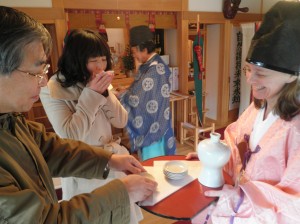
Serving 'omiki' (sacred saké) at Asakawa Konpira
4) It’s said the Shinto establishment is largely right-wing. As someone engaged politically on the left, have you found any conflict with your Shinto beliefs?
None whatsoever with my beliefs. I sometimes feel in conflict with the Shinto establishment, but I feel there is a lot of room in Shinto (perhaps more than in other religions) for diverse beliefs and positions. I remember reading an article on a group of World War 2 veterans who would have annual reunions at the Yasukuni Shrine, that bastion of the right-wing, but some of them were members of the Communist Party, some of them thought it was terrible that the War Criminals had also been enshrined there, some believed that Japan should pull out of the US alliance—there was a whole spectrum of opinions and thoughts, yet they all came together once a year and conducted a Shinto ceremony for their fallen comrades. My own beliefs are very simple and revolve around the wonder of nature; they have nothing to do with the Emperor, the ‘Japanese Nation’ or wearing hinomaru hachimaki. Obviously I sometimes have a hard time with people who try to claim that this political construction is what Shinto is all about. Luckily I don’t meet too many people like that.
5) What are you doing now in India, and how does your training as a Shinto priest fit into your future?
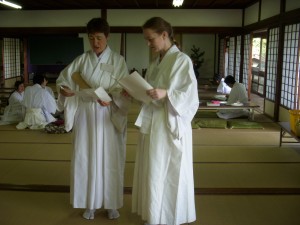
Caitlin discusses with Pat Ormsby the reading of a prayer
I’m doing a Ph.D. on nuclear power policy and anti-nuclear movements in India and Japan. Basically, I’m a political science scholar, and this has always tended to be the way I’ve viewed the world. In fact it was my work on the environmental movement when I was doing my Master’s Degree in Japan that brought me into contact with Asakawa Konpira. What a lucky break that was! If it wasn’t for that meeting and my subsequent priest training I may well have gone through the rest of my life seeing the environment in purely political terms. I was reminded of the spiritual and emotional aspects of my relationship with nature and I think this has made my life much more balanced. I am still very interested in the link between politics and religion and how any religion, including Shinto, can be manipulated politically. In terms of the future, I do plan to come back to Japan and I would really like to see what new directions I can take regarding Shinto on both local and international levels. I think there are lots of unmet needs, and in some cases open wounds, in local communities in these times of social and economic upheaval which ceremony can be very powerful in addressing. There is also a need, I think, to explain and promote Shinto on a more international level, in peace and environmental organizations, for example.
6) I wonder if you’ve had the opportunity to compare Shinto with Hinduism at all?
A little—not as much as I would like, but living in India, you can’t help bumping into Hinduism all the time. I think Hinduism and Shinto are very similar in lots of ways—polytheistic is the obvious one, and indeed some gods came to Japan via Hinduism. Benten-sama is originally the Hindu goddess Saraswati and in fact the god of the shrine I belong to, Konpira, has been traced to the Hindu crocodile god that is the vehicle for Ganga, the goddess of the river Ganges. There are also many differences, Hinduism having a much more developed philosophical angle, as well as of course the Vedas and myriad other texts, laws and commentaries, which are largely absent in Shinto traditions. The thing that is very interesting for me is that Hinduism has been (and continues to be) used in the same way that Shintoism was, to whip up nationalism and for very political ends. I guess fundamentalists of any ilk have more in common with each other than with the actual practitioners of the religions they are trying to redefine.
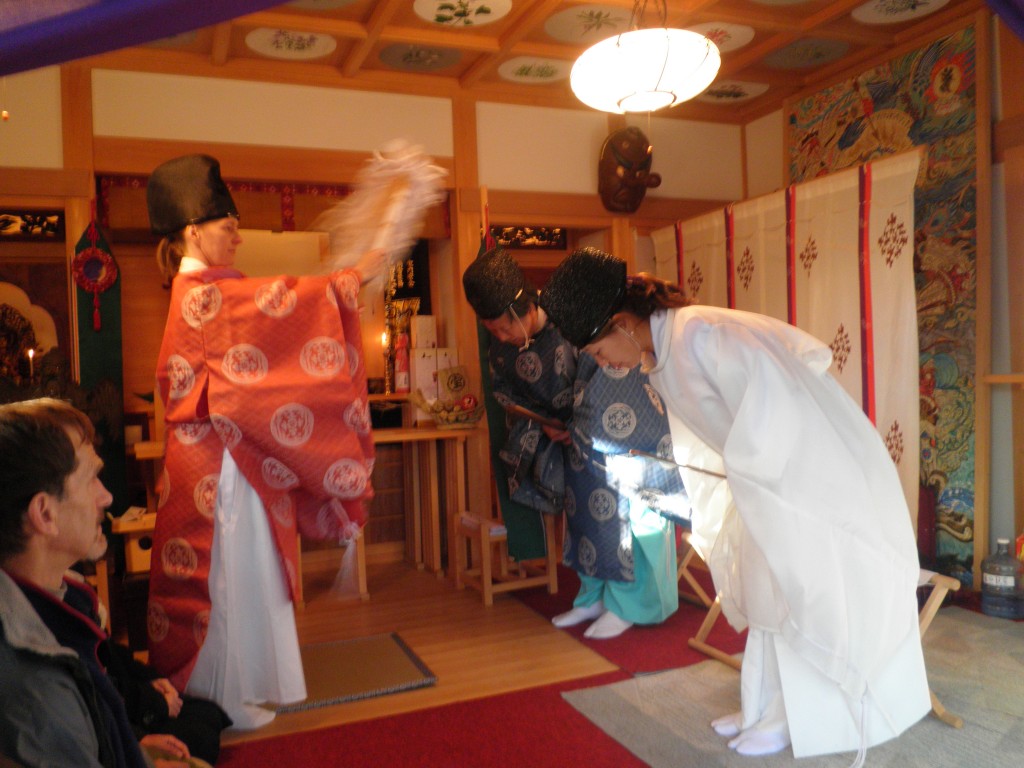
Purifying other priests at the Asakawa Konpira shrine

Leave a Reply